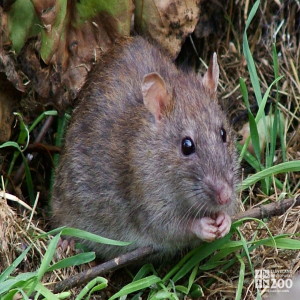Norway Rat
[Rattus norvegicus]

The Norway Rat has a stocky, powerful build. Like all rats it has a slender, scaly tail and long, sharp claws. There are between 180 and 200 rings on the tail, which is shorter than the body. Length ranges from 8 to 10 inches, not including the tail, and the weight up to 16 ounces. The ears are small, the snout blunt, and the fur coarse. Color varies from brownish-gray to reddish-gray. Lab rats (albinos) are descended from brown rats. They originated in Asia, and spread throughout the world on ships and overland. Like all rodents, they have chisel-like front teeth especially suited for gnawing.
Location: Animals Formerly at Zoo
Share:
Range
The range of the Norway Rat is worldwide.
Habitat
The Norway Rat lives in close association with humans.
Conservation Status
Least ConcernPrimary Threats
Gestation
Gestation in Norway Rats is 22 to 24 days.
Litter
Norway Rats can average 8 in a litter and can produce 800 young per year in captivity; less in the wild.
Behavior
Norway rats live in large groups of from 60 to 200, with certain rats being dominant. Most individuals build a nest in or near buildings. They are found under floors, within walls, in piles of garbage, or in the ground. They are cautious creatures, and usually avoid anything unfamiliar in their environment. They have a keen sense of smell and can quickly detect approaching danger. If the first few to encounter poison bait reject it, all of the pack will reject it. If it is accepted the entire pack will die. The norway rat is fierce and aggressive, compared with the milder Black rat. They feed mostly at night. Most of them live within an area that may be no more than 150 feet in diameter. But if a food shortage occurs, they may travel long distances in search of food. They can survive on the simplest food, but not long without water. They can dive and swim, and are sometimes called “water rats”. They carry food back to their burrows and stash it. They exhibit carnivore behavior when catching birds, a rare occurrence in lower mammals. Few rats live more than a year in their natural surroundings because they have so many enemies. Their predators include cats, dogs, hawks, owls, snakes, and weasels.
Reproduction
Most norway rats mate the year around, and the females give birth to 3 to 6 litters annually. A female rat carries her young in her body for about 3 weeks before they are born. Most litters contain up to 8 babies. The young are born blind and leave the nest after 22 days to romp and play. The entire pack helps raise the young.
